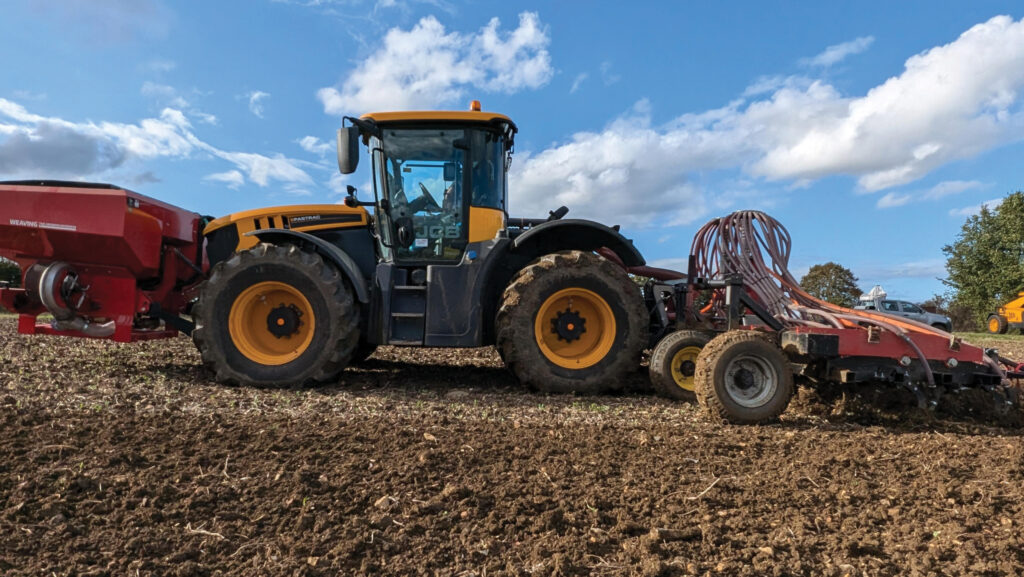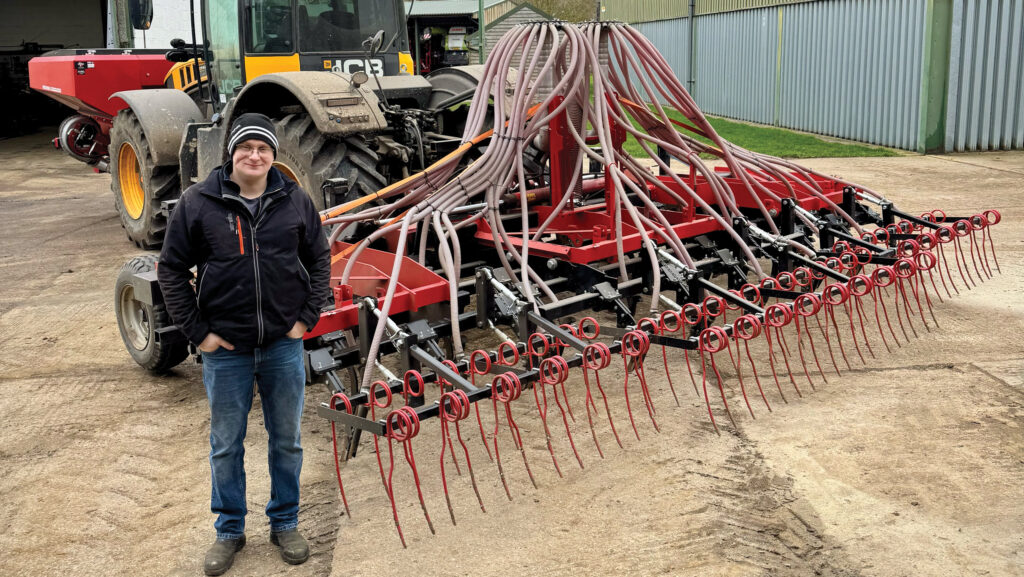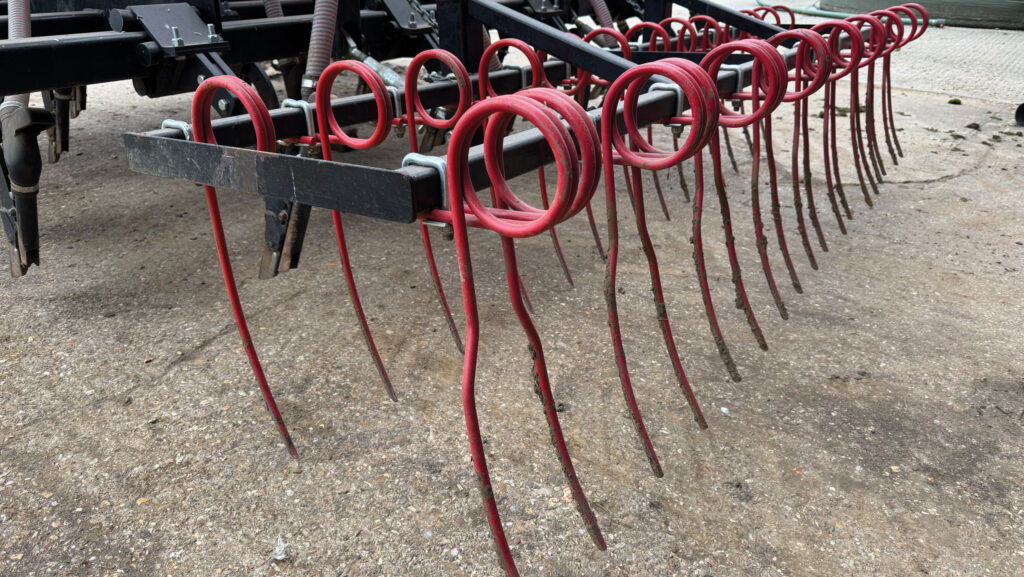Bedforshire farmer builds 6m low-disturbance drill for wet ground
 © MAG/Oliver Mark
© MAG/Oliver Mark Nothing gets the cogs of a creative mind whirring quite like the pitter-patter of rain on the workshop roof when there’s field work to get done.
With Green End Farm’s autumn drilling campaigns increasingly interrupted by inclement weather, Richard Darling hatched a plan to build an outfit better equipped for travelling on soft, wet ground.
Previous fallback had been a second-hand 6m Kverneland TS, but its versatility was hampered by having its hopper mounted above the coulters, which put too much weight on the rear axle of his JCB Fastrac 4220.
“It was a great little drill, but you could see every set of wheelings as the crop emerged and the wide points took a fair bit of pulling,” says Richard.
See also: Drill rebuild gives grower isobus-ready Vaderstad for sub-£10k
“Autumn 2023 was a particularly horrible season – and its last.
“We did what we could with it, but conditions were desperate and we were under the crunch.
“The fields looked dreadful and, in hindsight, we should have stopped and left it rather than soldiering on, but it made me more determined to find an alternative.”
Richard Darling’s low-disturbance drill
- Width 6m
- Hopper Weaving front tank
- Seed capacity 1.5t
- Coulters JJ Metcalfe low-disturbance shanks
- Spacing 158mm
- Section control Half-width (3m)
- Consolidation Double following harrow
Buying new was out of the question, given the implement would play second fiddle to the farm’s Horsch Sprinter.
In a good year, this is expected to take care of all 700ha of autumn drilling behind a Cruiser cultivator.
“It wasn’t worth spending big on the drill given its workload will vary wildly depending on field conditions,” he says.
“It’s a wet-weather drill, though, as it happens, it ended up putting in the best part of 250ha last October.”

Richard Darling © MAG/Oliver Mark
Key to its success so far has been having the hopper mounted on the front and the toolbar on the back of the tractor to improve weight distribution.
Tine coulters were also a must, purely for their versatility.
Second-hand headstock
To speed up the project and avoid the geometrical complexities of designing a folding frame, Richard tracked down an oven-ready option.
Originally part of a Grimme bedformer, the chunky headstock and wings – minus the depth wheels, which the seller wanted to keep – cost £1,200.
“Devising the folding system is the tricky bit of any build.
“The Grimme unit isn’t perfect, and I’d probably start from scratch next time, but there was some peace of mind in knowing it would work,” says Richard.
“Plus, it’s heavy-duty, and that weight helps keep the coulters in the ground when we’re direct-drilling.”
A set of four depth wheels, reclaimed from an old trailer, run just in front. This puts them on undisturbed ground well ahead of the coulters, so they’re very unlikely to bung up.
Providing the height adjustment are a series of trailer jacks to which the wheels are attached, allowing Richard to wind them up and down to alter his drilling depth.
The one downside of the design, he says, is that they’re positioned on the outside of the main frame, which pushes the transport width to a slightly ungainly 3.5m.
“It’s not ideal,” Richard concedes. “But we don’t tend to take it too far from the farm and, frankly, it’s only 30cm wider than the Sprinter.”
One other addition to the toolbar’s front was a pair of narrow Simba legs kitted out with wide-winged track eradicators to lift any compaction behind the tractor’s wheels.
Skinny legs
Richard’s intention was to string 36 coulters across four rows, but it didn’t quite work as planned.
For starters, positioning said coulters proved more awkward than expected, as they clashed with parts of the frame structure.
The simple solution was to reconfigure the layout by adding in a couple more and reducing their spacings to 158mm.
The four-row format was also revised following a field test.
With trash tangling too frequently, he shifted a handful of the legs forwards on simple box-section extensions from their original mounting points. The result was transformative, he says.

© MAG/Oliver Mark
Like many a drill self-builder, Richard opted for complete coulter assemblies from Yorkshire-based JJ Metcalfe.
“They were cheaper than the alternative from Weaving, seriously low-disturbance, and robust enough to handle some direct-drilling,” he says.
“As it’s such a stiff tine, Metcalfe recommended mounting them on 6mm-walled box section – I decided to go with chunky 80mm box, just to give it a bit more rigidity.”
The units came in at £180 apiece, including the clamping bracket complete with rubber sausages for suspension.
And the narrow, wingless 12mm shank has both a tungsten-tipped point and hard-facing caked down its flanks, which should keep running costs to a minimum.
On the back of the drill, he opted for a double following harrow.
It was free and already in stock, having been salvaged from the now defunct Cultivating Solutions following its unsuccessful attempt to build the farm a 12m drill a decade ago.

© MAG/Oliver Mark
This is mounted on four turnbuckles, allowing Richard to alter the angle of the attack according to the prevailing field conditions.
The tines are swept right back in heavy trash, while in cleaner fields they’re swung into a near-vertical position to produce more tilth and a smooth, raked finish that’s ideal for subsequent pre-emergence sprays.
“The harrow does a fabulous job,” he adds.
“It produces so much tilth and a lovely seed-bed – helped by the fact the Metcalfe legs are so narrow and don’t leave much of a slot to fill in.”

© MAG/Oliver Mark
Weight balance
Up front, the farm spent big on a brand-new, 1.5t-capacity Weaving hopper.
This came with twin metering units that allow for half-width shut-off, transfer pipes for the side of the tractor, and cameras.
Weaving also supplied the distribution heads and little rubber boots on each coulter assembly, the cost of which was part funded by trading in a hydraulic fan and metering units – further remnants of the Cultivating Solutions debacle.
No surprise that the lion’s share of the budget went on the hopper – at £20,000, it accounted for two-thirds of the total £30,000 build cost.
However, that still compares favourably to the cost of a Weaving Sabre Tine toolbar and front tank, and his version offers exactly the same perks, most notable of which is the more even spread of weight across the tractor.
And to further reduce the outfit’s impact on the soil, he snapped up a set of 710mm tyres found on Facebook Marketplace for £7,000, giving the Fastrac a far bigger footprint than before.
The timing of his build couldn’t have been better, with dismal early autumn weather seeing it called into heavy action.
“We started the season with it working on its own, until conditions improved enough to get the Sprinter out.

© MAG/Oliver Mark
“It was easy work for the Fastrac, which cruised along at about 9-10kph with the tines about 3in deep,” says Richard.
“Both then ran for the rest of the autumn, the Sprinter sticking to the biggest fields and the 6m in smaller fields and around headlands.
“Now that the crops are up, there’s nothing to split them in terms of condition.”
Any changes?
“Nothing major,” says Richard. “The only real downside is that we can’t apply phosphate at the same time, which we can on the Sprinter.
“I’ve also found that it wiggles around slightly in some fields, so the rows aren’t arrow straight.
“I think it’s where the depth wheels catch lines left by the subsoiler but it’s not a big deal – it’s purely aesthetic.”
Future mods might include adding bout markers, though there not a necessity as the corner of the Fastrac mudguard lines up neatly with the edge of the previous pass, and a set of packer wheels underneath the hopper. But, he says, neither are essential.
Next up? “I’d like to build a trailed 9m, though I think my boss might take some convincing.”

